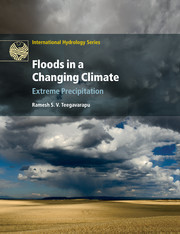Description
Floods in a Changing Climate
Extreme Precipitation
International Hydrology Series
Author: Teegavarapu Ramesh S. V.
Provides measurement, analysis and modeling methods for assessment of trends in extreme precipitation events, for academic researchers and professionals.
Language: English
Subjects for Floods in a Changing Climate:
67.54 €
In Print (Delivery period: 14 days).
Add to cart
Floods in a Changing Climate
Publication date: 03-2018
Support: Print on demand
Publication date: 03-2018
Support: Print on demand
Approximative price 99.37 €
In Print (Delivery period: 14 days).
Add to cart
Floods in a changing climate: extreme precipitation
Publication date: 11-2012
285 p. · 22.2x28.1 cm · Hardback
Publication date: 11-2012
285 p. · 22.2x28.1 cm · Hardback
Description
/li>Contents
/li>Biography
/li>
Measurement, analysis and modeling of extreme precipitation events linked to floods is vital in understanding changing climate impacts and variability. This book provides methods for assessment of the trends in these events and their impacts. It also provides a basis to develop procedures and guidelines for climate-adaptive hydrologic engineering. Academic researchers in the fields of hydrology, climate change, meteorology, environmental policy and risk assessment, and professionals and policy-makers working in hazard mitigation, water resources engineering and climate adaptation will find this an invaluable resource. This volume is the first in a collection of four books on flood disaster management theory and practice within the context of anthropogenic climate change. The others are: Floods in a Changing Climate: Hydrological Modeling by P. P. Mujumdar and D. Nagesh Kumar, Floods in a Changing Climate: Inundation Modeling by Giuliano Di Baldassarre and Floods in a Changing Climate: Risk Management by Slodoban Simonovi?.
Part I. Precipitation Processes and Measurement: 1. Precipitation and climate change; 2. Precipitation measurement; 3. Spatial analysis of precipitation data; Part II. Extreme Precipitation, Floods and Climate Change: 4. Extreme precipitation and floods; 5. Precipitation modeling and climate change; Part III. Precipitation Variability, Teleconnections and Trends: 6. Precipitation variability and teleconnections; 7. Global precipitation trends and variability; Part IV. Hydrologic Modeling and Design in a Changing Climate: 8. Hydrologic modeling and design; 9. Future perspectives; References; Index.
Ramesh S. V. Teegavarapu is an Assistant Professor in the Department of Civil, Environmental and Geomatics Engineering at Florida Atlantic University, and is leader of the Hydrosystems Research Laboratory in that department. His main area of specialization is water resources with focuses on climate change modeling, precipitation extremes and hydrological process. He is a member of the Water Resources Management Committee of the International Association for Hydro-Environment Engineering and Research (IAHR). Dr Teegavarapu currently serves on the editorial board of two international journals and has published over 100 articles in journals and conference proceedings. He has convened, chaired and moderated over fifty sessions at several international conferences and served as vice-chair for task committees related to radar rainfall and uncertainty analysis approaches under the Surface Water Hydrology Technical Committee (SWHTC) of the American Society of Civil Engineers (ASCE).
© 2024 LAVOISIER S.A.S.




